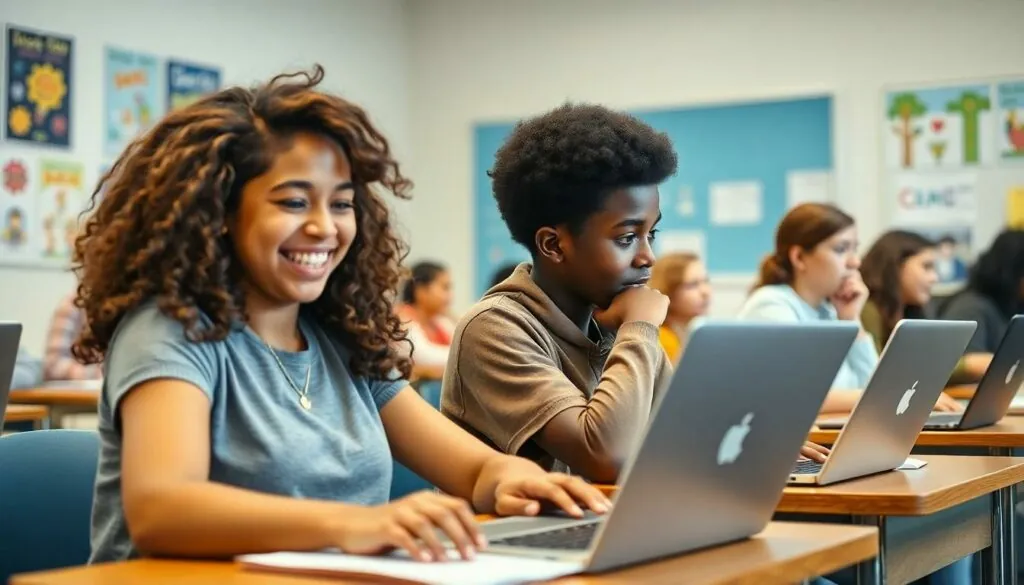In today’s tech-savvy classroom, students often wonder if their teachers can spot the digital rabbit holes they dive into, like ChatGPT. It’s like sneaking a snack before dinner—exciting but risky. With AI tools becoming increasingly popular, the question lingers: can educators really tell when students are getting a little help from their virtual friends?
Table of Contents
ToggleUnderstanding ChatGPT and Its Usage
ChatGPT represents a sophisticated AI tool capable of generating human-like text based on prompts. Educators encounter challenges when determining if students utilize this technology for academic tasks. Some students may seek assistance from ChatGPT for assignments, impacting the authenticity of their work.
Using ChatGPT often means relying on its capabilities for crafting essays, answering questions, or brainstorming ideas. Many students find it an appealing resource for overcoming writer’s block or generating quick responses. However, the ease of access may lead to a reliance on AI that diminishes original thinking.
Concerns arise regarding academic integrity whenever students use AI tools like ChatGPT. Teachers emphasize the importance of independent learning and original contributions. Some educational institutions implement guidelines addressing AI usage, promoting transparency and ethical practices.
Detection methods vary among educators aiming to identify AI-generated content. Many teachers review written assignments for style inconsistencies or responses that lack depth. Instructors also may notice a disconnect between a student’s typical writing style and the output produced by ChatGPT.
Overall, understanding the implications of using ChatGPT shapes discussions around academic honesty. Students and teachers share a mutual responsibility in navigating the landscape of AI-assisted learning. By fostering open communication about these tools, both parties can focus on learning outcomes and personal growth.
Detection Methods by Educators
Educators employ various methods to determine if students use AI tools like ChatGPT for their assignments. Understanding these detection methods supports academic integrity and promotes responsible AI use.
Tools and Software
Many educators utilize specialized tools and software to detect AI-generated content. Platforms like Turnitin and Copyscape check for originality and can highlight similarities with AI writing patterns. Some educators analyze linguistic features, using AI-driven analyzers designed to discern human-written texts from machine-generated outputs. Other advanced software options assess coherence and contextual relevance, providing insights into the authenticity of a student’s work.
Behavioral Indicators
Students often exhibit behavioral indicators that may suggest AI usage. A sudden change in writing style can raise suspicion, especially if work markedly improves in sophistication or complexity. Inconsistencies in tone or vocabulary diversity might also indicate reliance on AI. Engagement levels during discussions about their work can also offer clues. Students who struggle to explain their thoughts or generate ideas verbally may depend on AI tools like ChatGPT for written assignments.
Privacy and Ethical Considerations
Privacy and ethics play critical roles in the conversation about AI usage in education. As students explore tools like ChatGPT, understanding confidentiality and academic integrity becomes essential.
Student Confidentiality
Student confidentiality remains a top priority for educational institutions. Personal data generated through AI interactions requires safeguarding to protect privacy. Many platforms, including ChatGPT, implement measures to ensure that users’ information remains confidential. Educators therefore must inform students about data handling practices. Transparency around these practices helps promote trust between students and schools. Keeping conversations private enhances the learning environment, allowing for open discussions without fear of exposure.
Academic Integrity
Academic integrity serves as the foundation of ethical education practices. Educators encourage originality in student work to foster genuine learning experiences. Reliance on AI for assignments can blur the lines of authenticity. Violations of academic integrity can lead to serious consequences, including disciplinary actions. Institutions often develop policies to address AI use while upholding academic standards. Educators also emphasize open communication about expectations. Students should feel empowered to seek help without compromising their integrity. By collaborating, teachers and students can navigate AI responsibly while maintaining high ethical standards.
Impact on Learning and Assessment
Understanding the role of AI tools like ChatGPT in education reveals both advantages and challenges for learners and educators alike.
Benefits of Using ChatGPT
Students gain rapid access to information and ideas when utilizing ChatGPT. Assistance with brainstorming, drafting, and editing enhances the writing process for many. Such tools serve as a source to alleviate writer’s block, providing prompts that stimulate creativity. Engagement with AI fosters technological proficiency, preparing learners for modern workplaces. It complements traditional learning methods, offering alternative perspectives on topics. For example, students can receive instant feedback, which boosts their writing skills over time. Overall, ChatGPT supports diverse learning styles, making educational experiences more inclusive.
Challenges Faced by Educators
Educators encounter significant obstacles when addressing AI usage in the classroom. Difficulty arises in detecting the use of AI-generated content, leading to concerns over academic integrity. Substantial variations in writing style can complicate assessment, creating confusion regarding a student’s true capabilities. Many educators lack effective tools for distinguishing between human and AI responses. When students frequently rely on AI, original thinking may decline, which hinders deeper understanding of material. Additionally, keeping pace with rapidly changing technology requires ongoing professional development for educators. Overall, the growing prevalence of AI necessitates adaptations in teaching approaches and assessment strategies.
Conclusion
The rise of AI tools like ChatGPT presents both opportunities and challenges in education. As students explore these resources for assistance, teachers must remain vigilant in promoting academic integrity. Open dialogue about the ethical use of AI fosters a collaborative environment where learning thrives.
Navigating this landscape requires a balance between leveraging technology and ensuring original thought. By encouraging transparency and understanding, both educators and students can adapt to the evolving educational landscape while maintaining high standards of integrity. Embracing responsible AI use will ultimately enrich the learning experience for everyone involved.




